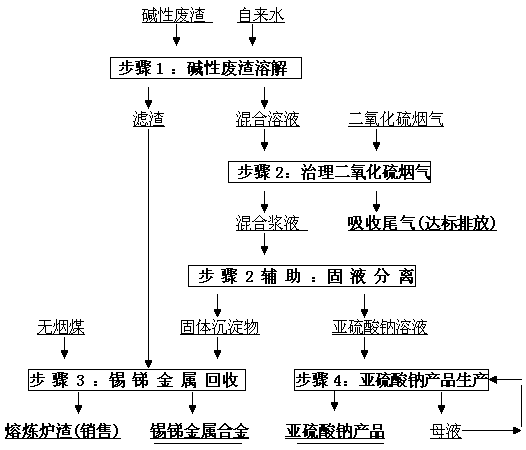Method for treating sulfur dioxide flue gas by using alkaline waste residues and recovering tin-antimony metals and sodium sulfite crystals
A sodium sulfite and sulfur dioxide technology, applied in the preparation of alkali metal sulfite, chemical instruments and methods, separation methods, etc., can solve the problems of slow reaction speed, low reaction efficiency, tin and antimony output, etc., and achieve high recovery rate, The effect of increasing economic benefits and shortening the technological process
- Summary
- Abstract
- Description
- Claims
- Application Information
AI Technical Summary
Problems solved by technology
Method used
Image
Examples
no. 1 example
[0077] (1), Dissolving alkaline waste residue: will contain Na 2 O15%, Sn1%, Sb2% alkaline waste residue 20t, crushed to particle size ≤ 10mm; then in 75m 3 In the leaching tank, add 40m 3 Tap water, turn on the leaching tank mixer, gradually add 20t of broken alkaline waste residue, heat up to 50°C, dissolve the alkaline substance and free sodium oxide in the alkaline waste residue in water, and after dissolving for 6 hours, filter with a filter press to obtain Wet state filter residue 18t and concentration are respectively NaOH: 95g / L, Sn: 5g / L, Sb: 10g / L, Si: 10g / L NaOH, NaOH 2 SnO 3 、Na 3 SbO 4 、Na 2 SiO 3 Mixed solution 36m 3 ; The wet filter residue enters step (3) for processing, and the mixed solution enters step (2) for processing.
[0078] (2) Treatment of sulfur dioxide flue gas: NaOH, Na 2 SnO 3 、Na 3 SbO 4 、Na 2 SiO 3 Mixed solution 36m 3 , by 0.375m 3 The speed of / h is continuously added to the single-stage absorption tower of Φ2800mm×H12000mm wi...
no. 2 example
[0083](1) Dissolving alkaline waste residue: crush 30 tons of alkaline waste residue containing Na2O25%, Sn2.5%, and Sb5% until the particle size is ≤10mm; 3 In the leaching tank, add 90m 3 Tap water, turn on the leaching tank mixer, gradually add 30t of crushed alkaline waste residue into the leaching tank, raise the temperature to 60°C, dissolve the alkaline substance and free sodium oxide in the alkaline waste residue in water, and after 9 hours of dissolution, use a filter press to Filtrate to obtain wet state filter residue 18.8t and concentration is NaOH: 107g / L, Sn: 8.3g / L, Sb: 16.6g / L, Si: 8g / L NaOH, NaOH 2 SnO 3 、Na 3 SbO 4 、Na 2 SiO 3 Mixed solution 84m 3 ; The wet filter residue enters step (3) for processing, and the mixed solution enters step (2) for processing.
[0084] (2) Treatment of sulfur dioxide flue gas: NaOH, Na 2 SnO 3 、Na 3 SbO 4 、Na 2 SiO 3 Mixed solution 84m 3 , according to 3.5m 3 Add it into the second-stage absorption tower of the tw...
no. 3 example
[0089] (1), Dissolving alkaline waste residue: will contain Na 2 o 3 5%, Sn4%, Sb8% alkaline waste residue 75t, crushed to particle size ≤ 10mm; then in a 500m 3 In the dense leaching tank, add 300m 3 Tap water, turn on the dense type leaching tank mixer, gradually add 75t of crushed alkaline waste residue into the dense type leaching tank, raise the temperature to 70°C, and dissolve the alkaline substance and free sodium oxide of the alkaline waste residue in water for 12 hours. Filter with a filter press to obtain a wet filter residue of 33.75t and a concentration of NaOH: 113g / L, Sn: 10g / L, Sb: 20g / L, Si: 5g / L NaOH, Na 2 SnO 3 、Na 3 SbO 4 、Na 2 SiO 3 Mixed solution 291m 3 ; The wet filter residue enters step (3) for processing, and the mixed solution enters step (2) for processing.
[0090] (2) Treatment of sulfur dioxide flue gas: NaOH, Na 2 SnO 3 、Na 3 SbO 4 、Na 2 SiO 3 Mixed solution 291m 3 , by 18.375m 3 Add it into the third-stage absorption tower of t...
PUM
 Login to View More
Login to View More Abstract
Description
Claims
Application Information
 Login to View More
Login to View More - R&D
- Intellectual Property
- Life Sciences
- Materials
- Tech Scout
- Unparalleled Data Quality
- Higher Quality Content
- 60% Fewer Hallucinations
Browse by: Latest US Patents, China's latest patents, Technical Efficacy Thesaurus, Application Domain, Technology Topic, Popular Technical Reports.
© 2025 PatSnap. All rights reserved.Legal|Privacy policy|Modern Slavery Act Transparency Statement|Sitemap|About US| Contact US: help@patsnap.com

